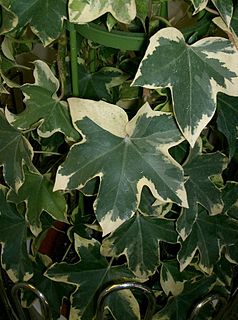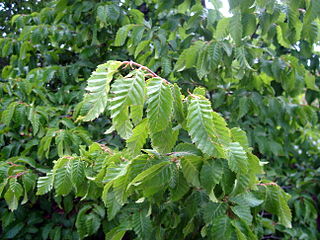
Kumquats are a group of small fruit-bearing trees in the flowering plant family Rutaceae. They were previously classified as forming the now-historical genus Fortunella, or placed within Citrus sensu lato.

Hornbeams are hardwood trees in the flowering plant genus Carpinus in the birch family Betulaceae. The 30–40 species occur across much of the temperate regions of the Northern Hemisphere.

Cryptomeria is a monotypic genus of conifer in the cypress family Cupressaceae, formerly belonging to the family Taxodiaceae. It includes only one species, Cryptomeria japonica. It used to be considered by some to be endemic to Japan, where it is known as sugi. The tree is called Japanese cedar or Japanese redwood in English.

Lonicera japonica, known as Japanese honeysuckle and golden-and-silver honeysuckle, is a species of honeysuckle native to eastern Asia. It is often grown as an ornamental plant, but has become an invasive species in a number of countries. Japanese honeysuckle is used in traditional Chinese medicine.

The loquat or أكدنيا in Arabic is a species of flowering plant in the family Rosaceae, a native to the cooler hill regions of south-central China. It is also commonly found in Japan, Korea, northern parts of the Philippines, Himachal Pradesh in India, the Pothohar Plateau in Pakistan, and hilly regions in Sri Lanka. It can also be found in southern European countries such as Bosnia and Herzegovina, Republic of Georgia, Turkey, Cyprus, Greece, Malta, Italy, Albania, Montenegro, Croatia, Slovenia, France, Spain and Portugal, several northern African countries including Morocco, Algeria and Tunisia, and in countries in the Middle East such as Lebanon, Israel, Iran, Syria, Iraq, Jordan, and Palestine. in parts of East Africa, like regions of Kenya, as well as in subtropical North American regions such as California, Texas, Louisiana, South Carolina and Florida.

Carpinus betulus, the European or common hornbeam, is a species of tree in the birch family Betulaceae, native to Western Asia and central, eastern, and southern Europe, including southern England. It requires a warm climate for good growth, and occurs only at elevations up to 600 metres (1,969 ft). It grows in mixed stands with oak, and in some areas beech, and is also a common tree in scree forests. Hornbeam was also known as 'Yoke Elm'.

Magnolia sieboldii, Siebold's magnolia, also known as Korean mountain magnolia and Oyama magnolia, is a species of Magnolia native to east Asia in China, Japan, and Korea. It is named after the German doctor Philipp Franz von Siebold (1796–1866).

Carpinus caroliniana, the American hornbeam, is a small hardwood tree in the genus Carpinus. American hornbeam is also known as blue-beech, and musclewood. It is native to eastern North America, from Minnesota and southern Ontario east to Maine, and south to eastern Texas and northern Florida. It also grows in Canada.

Kerria japonica, also known as the Japanese marigold bush or miracle marigold bush in the northern New England area and as yamabuki (山吹) in Japan, is a deciduous shrub in the rose family Rosaceae, native to China, Japan and Korea. It is named after William Kerr, who introduced the cultivar 'Pleniflora'. It is the sole species in the genus Kerria; its genus name is also used as a common name (kerria).

Ulmus davidiana var. japonica, the Japanese elm, is one of the larger and more graceful Asiatic elms, endemic to much of continental northeast Asia and Japan, where it grows in swamp forest on young alluvial soils, although much of this habitat has now been lost to intensive rice cultivation.

×Fatshedera lizei is a hybrid of flowering plants, common name tree ivy or aralia ivy. The hybrid symbol × in front of the name indicates that this is an inter-generic hybrid, a cross between plants from different genera. ×F. lizei was created by crossing Fatsia japonica 'Moserii' and Hedera helix at the Lizé Frères tree nursery at Nantes in France in 1912. Its generic name is derived from the names of the two parent genera.

Fatsia japonica, also glossy-leaf paper plant, fatsi, paperplant, false castor oil plant, or Japanese aralia, is a species of flowering plant in the family Araliaceae, native to southern Japan, southern Korea, and Taiwan.

Acer carpinifolium is a species of maple native to Japan, on the islands of Honshū, Kyūshū, and Shikoku, where it grows in woodlands and alongside streams in mountainous areas.

Mahonia oiwakensis is a species of plant in the barberry family, Berberidaceae. It is native to China and Myanmar, where it occurs at elevations of 600 to 3800 m. It has recently been found naturalized in South Africa.

Carpinus orientalis, known as the Oriental hornbeam, is a hornbeam native to Hungary, the Balkans, Italy, Crimea, Turkey, Iran, and the Caucasus. and occurs usually on hot dry sites at lower altitudes in comparison to the Carpinus betulus.

Acer palmatum, commonly known as red emperor maple, palmate maple, Japanese maple or smooth Japanese-maple, is a species of woody plant native to Japan, Korea, China, eastern Mongolia, and southeast Russia. Many different cultivars of this maple have been selected and they are grown worldwide for their large variety of attractive forms, leaf shapes, and spectacular colors.

Pseudosasa japonica, the arrow bamboo or metake, is a species of flowering plant in the grass family Poaceae, native to Japan and Korea. This vigorous bamboo forms thickets up to 6 m (20 ft) tall with shiny leaves up to 25 cm (9.8 in) long. The culms are typically yellow-brown and it has palm-like leaves.

Fatih Sultan Mehmet Nature Park is a nature park located in Sarıyer district of Istanbul Province, Turkey.

Styrax japonicus (野茉莉), the Japanese snowbell, is a species of flowering plant in the family Styracaceae, native to China, Japan and Korea. Growing to 12 m (39 ft) tall by 8 m (26 ft) broad, it is a graceful, spreading deciduous tree with oval, upward-facing leaves which occasionally turn yellow or orange before falling in autumn. Masses of slightly fragrant, bell-shaped white flowers hang from the branches in summer, followed by fruits (drupes) which resemble olives in both shape and colour.



















